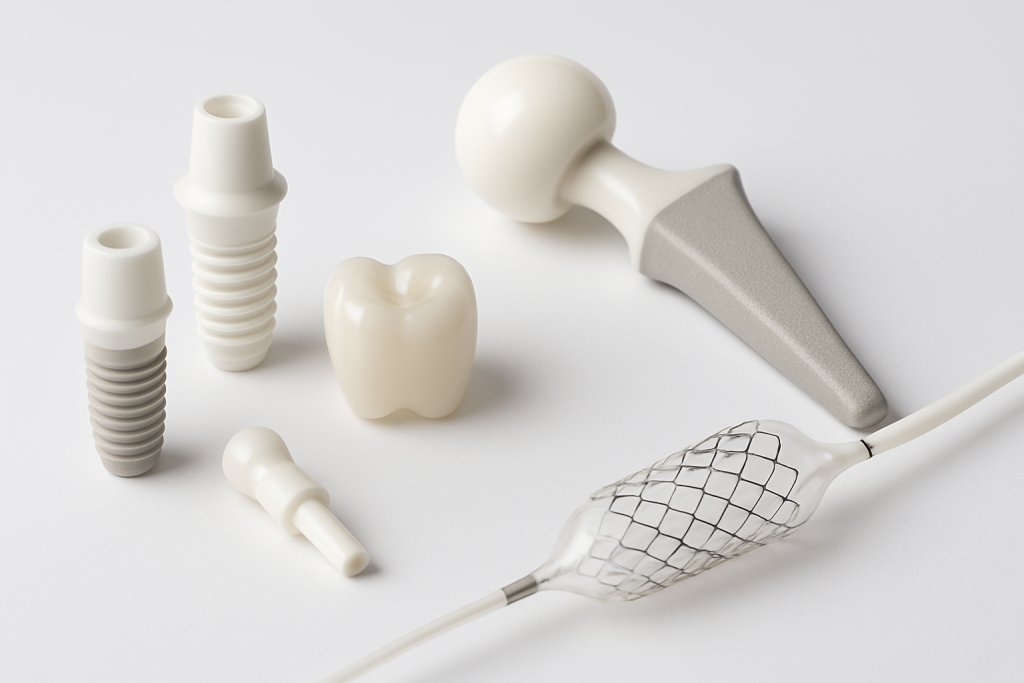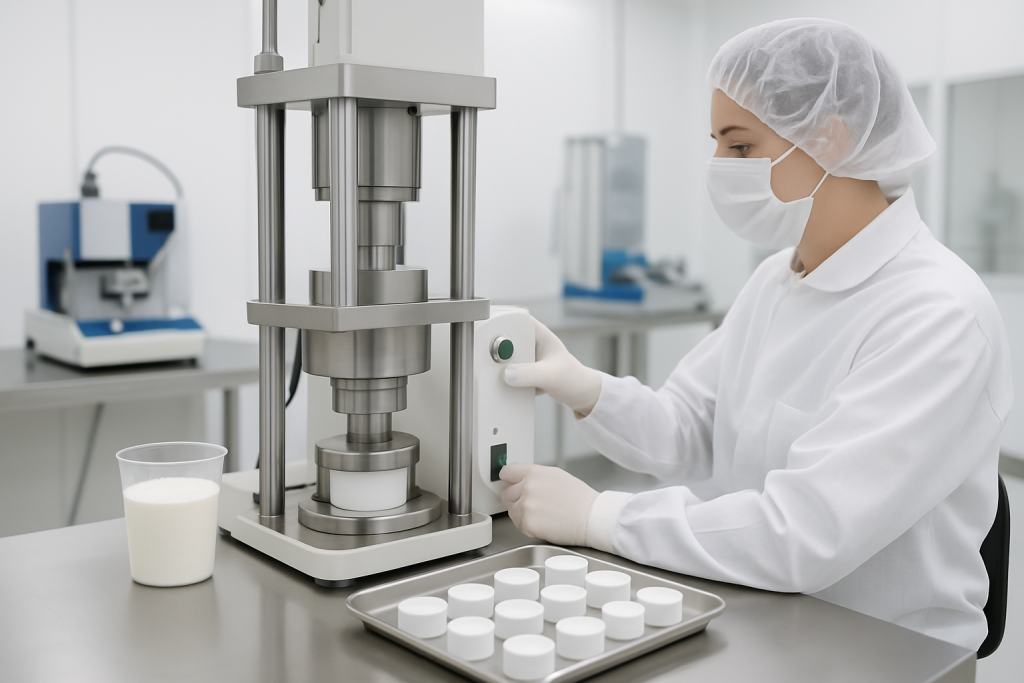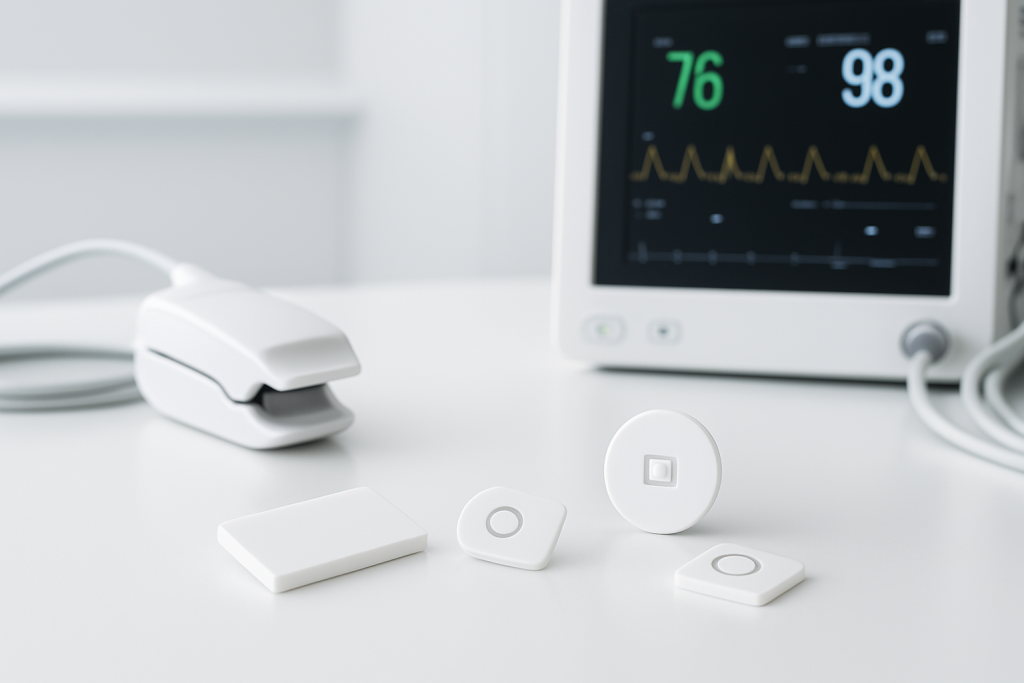The medical device industry is experiencing a materials science revolution, with ceramic materials at the forefront of this transformation. In recent years, significant innovations in zirconia technology have expanded its applications across multiple medical fields. These advancements address critical challenges in biocompatibility, durability, and performance that traditional materials struggle to overcome. This article examines how these innovations are reshaping medical devices and improving patient outcomes through superior material properties and manufacturing techniques.
What Makes Zirconia a Superior Material for Medical Applications?
Let me show you why zirconia stands out among medical materials. Zirconia (ZrO₂) possesses a unique combination of physical and chemical properties that make it exceptionally suitable for medical applications. Its high flexural strength (900-1200 MPa) and fracture toughness (5-10 MPa·m½) provide durability in demanding medical environments, while its biocompatibility ensures safe interaction with human tissues.
The material’s white color and translucency offer aesthetic advantages over metallic alternatives, particularly important in dental and visible medical applications. The chemical stability prevents corrosion and ion release, addressing concerns associated with metal allergies and tissue reactions.
| Property | Zirconia | Titanium | Medical-Grade Polymers |
|---|---|---|---|
| Flexural Strength | 900-1200 MPa | 900-950 MPa | 50-120 MPa |
| Biocompatibility | Excellent | Good | Variable |
| Corrosion Resistance | Excellent | Good | Excellent |
| Aesthetic Properties | High (white, translucent) | Poor (metallic) | Moderate |
| Wear Resistance | Excellent | Good | Poor to Moderate |
Different types of medical-grade ceramic materials offer specialized properties for specific applications. Yttria-stabilized tetragonal zirconia polycrystal (Y-TZP) provides high strength and is widely used in dental implants. Magnesia partially stabilized zirconia (Mg-PSZ) offers excellent fracture resistance for high-stress applications. Alumina-toughened zirconia (ATZ) composites combine the best properties of both ceramics for enhanced performance.
Regulatory bodies worldwide have recognized zirconia’s safety profile, with materials meeting ISO 13356 standards for surgical implants and FDA approval for various medical applications, according to the International Organization for Standardization. This regulatory acceptance has accelerated adoption across the healthcare industry.

How Have Manufacturing Techniques Advanced Zirconia Production?
You might be wondering how recent manufacturing breakthroughs have transformed ceramic production. Traditional ceramic processing has evolved dramatically, with innovations occurring at every stage from powder preparation to final finishing.
Nanoscale powder production has seen remarkable progress. Modern chemical precipitation and sol-gel methods now yield ultra-fine powders with particle sizes below 100 nm, resulting in finished products with superior homogeneity and mechanical properties. These nanopowders enable the creation of complex geometries with exceptional detail and strength.
Advanced forming techniques have revolutionized how ceramic components are shaped:
| Manufacturing Technique | Key Advantages | Typical Applications |
|---|---|---|
| Injection Molding | Complex shapes, high volume production | Dental brackets, small implant components |
| Cold Isostatic Pressing | Uniform density, minimal defects | Orthopedic components, dental blanks |
| 3D Printing | Custom geometries, rapid prototyping | Patient-specific implants, complex structures |
| Gel Casting | Near-net shapes, fine details | Precision components, thin-walled structures |
| Tape Casting | Thin sheets, layered structures | Sensors, electronic substrates |
Sintering technology has similarly advanced. Microwave sintering reduces processing time from hours to minutes while ensuring uniform densification. Spark plasma sintering (SPS) applies pressure and electric current simultaneously, achieving full density at lower temperatures and preserving nanoscale features. These methods reduce energy consumption while improving material properties.
Surface treatment innovations have enhanced functionality. Laser texturing creates precise micro and nano-scale surface patterns that promote cell adhesion and tissue integration. Plasma treatments modify surface chemistry to improve bonding with other materials. These advancements have expanded application range and improved clinical outcomes.
Quality control has kept pace with manufacturing innovations. Advanced non-destructive testing methods, including micro-CT scanning and acoustic emission testing, ensure component integrity without damage. Statistical process control and machine learning algorithms monitor production parameters in real-time, maintaining consistency across batches.

What Breakthrough Applications Are Emerging in Dental Medicine?
Here’s the thing about ceramic materials in dentistry: they’re completely changing patient expectations and treatment outcomes. The latest generation of dental restorations combines strength with unprecedented aesthetics, addressing limitations of earlier materials.
Full-contour ceramic crowns and bridges represent a significant advancement. Unlike traditional porcelain-fused-to-metal restorations, these monolithic structures eliminate veneer chipping while providing natural-looking translucency. High-translucency variants contain optimized crystal structures that balance light transmission with mechanical strength.
| Ceramic Type | Translucency | Strength | Ideal Applications |
|---|---|---|---|
| 3Y-TZP | Low | 900-1200 MPa | Posterior bridges, implant abutments |
| 4Y-TZP | Medium | 750-900 MPa | Anterior and posterior crowns |
| 5Y-TZP | High | 600-750 MPa | Anterior restorations, veneers |
| Multilayer | Gradient | Variable | Full-arch restorations |
CAD/CAM technology has transformed ceramic processing in dentistry. Digital workflows now enable same-day restorations with exceptional fit and function. Advanced software algorithms analyze bite forces and material thickness requirements, optimizing designs for each patient’s unique conditions. Multi-axis milling machines produce complex geometries with micron-level precision, while newer systems incorporate additive manufacturing for certain components.
Surface modifications have improved dental implant performance. Laser-etched microgrooves promote directional bone growth, while hydrophilic surface treatments accelerate osseointegration. Clinical studies show bone-to-implant contact rates exceeding 70% within weeks of placement, comparable to the best titanium implants but with reduced inflammatory response.
Personalized prosthetics represent another breakthrough area. Digital smile design protocols combine facial scanning, intraoral imaging, and patient preferences to create highly customized restorations. These techniques achieve superior functional and aesthetic outcomes while reducing chair time and improving patient satisfaction.
Long-term clinical studies now support durability in dental applications. Five-year survival rates for ceramic crowns exceed 95%, with minimal biological complications. Patient satisfaction scores consistently rank higher for these restorations compared to metal-based alternatives, particularly for visible anterior teeth.
How Is Zirconia Transforming Orthopedic Implant Technology?
The truth is, ceramic innovations are reshaping orthopedic medicine through improved implant designs and material formulations. Joint replacement components benefit particularly from zirconia’s unique properties.
Ceramic femoral heads for hip replacements demonstrate exceptional wear resistance and biocompatibility. Modern zirconia-toughened alumina (ZTA) composites have overcome the stability issues that affected early components, with hydrothermal degradation rates reduced by over 90%. These materials now show wear rates below 0.1mm³/million cycles in simulator testing, potentially extending implant lifespans to 20+ years.
| Orthopedic Application | Ceramic Advantage | Clinical Benefit |
|---|---|---|
| Hip replacement heads | Low friction, high wear resistance | Reduced revision rates, longer implant life |
| Knee components | Low wear against polyethylene | Reduced particle debris and osteolysis |
| Spinal implants | Radiolucency, biocompatibility | Improved imaging, reduced inflammation |
| Small joint replacements | Strength in small dimensions | Preserved bone stock, minimally invasive options |
| Trauma fixation | Bioinert properties | Reduced infection risk, no metal sensitivity |
Ceramic-polyethylene bearing surfaces show remarkable improvements in wear characteristics. Advanced manufacturing techniques create ultra-smooth surfaces with roughness values below 0.02μm. When articulating against highly cross-linked polyethylene, these surfaces generate minimal wear particles, addressing a primary cause of aseptic loosening and implant failure.
Composite materials have overcome traditional ceramic limitations. Zirconia-based composites with silicon nitride or carbon fiber reinforcement demonstrate fracture toughness values approaching those of metals (15-20 MPa·m½) while maintaining ceramic biocompatibility. These materials enable new designs previously impossible with conventional ceramics.
Antibacterial surface treatments represent another significant innovation. Silver-doped ceramic surfaces reduce bacterial colonization by over 99% compared to untreated surfaces. Copper and zinc oxide nanoparticle incorporation creates surfaces that actively inhibit biofilm formation without cytotoxicity to human cells, addressing the critical challenge of implant-associated infections.
Clinical outcomes data increasingly supports ceramic orthopedic applications. Registry data shows comparable or better functional scores for patients with modern ceramic components compared to traditional materials, with significantly reduced rates of metal ion-related complications and allergic responses, as reported by the American Academy of Orthopaedic Surgeons.
What Role Does Zirconia Play in Next-Generation Cardiovascular Devices?
You need to know how advanced ceramics are advancing cardiovascular medicine through specialized applications that leverage their unique properties. Heart valve components represent a primary application area where durability and blood compatibility offer significant advantages.
Ceramic heart valve components demonstrate exceptional hemodynamic properties. Highly polished surfaces with roughness values below 0.02μm minimize blood cell damage and platelet activation. Mechanical heart valves incorporating ceramic components show thrombogenicity rates 30-40% lower than traditional pyrolytic carbon valves in clinical studies, potentially reducing anticoagulation requirements.
| Cardiovascular Application | Ceramic Component | Key Benefit |
|---|---|---|
| Mechanical heart valves | Valve leaflets, hinges | Reduced thrombogenicity, improved durability |
| Vascular stents | Stent coating, drug delivery matrix | Reduced inflammation, controlled drug release |
| Pacemaker components | Hermetic feedthroughs, casings | Enhanced durability, MRI compatibility |
| Cardiac sensors | Pressure sensors, oxygen monitors | Miniaturization, biocompatibility |
| Catheter components | Positioning markers, structural elements | Radiopacity, structural integrity |
Blood-compatible ceramic coatings have transformed vascular implants. Thin-film coatings (1-5μm) applied via atomic layer deposition create non-thrombogenic surfaces on metal stents and other blood-contacting devices. These coatings reduce inflammatory responses by over 60% compared to bare metal surfaces while providing corrosion protection and drug-eluting capabilities.
Miniaturized components enable advanced cardiac rhythm management devices. Zirconia’s excellent electrical insulation properties (resistivity >10¹⁴ Ω·cm) make it ideal for hermetic feedthroughs in pacemakers and defibrillators. These components maintain seal integrity under extreme conditions while allowing devices to shrink by up to 40% compared to previous generations.
The role in cardiovascular imaging and diagnostics continues to expand. Radiopaque ceramic markers provide precise positioning information during interventional procedures without the artifacts associated with metallic markers. Ceramic-based ultrasound transducers offer improved sensitivity and resolution for intravascular imaging, enhancing diagnostic capabilities.
Clinical outcomes data shows promising results for ceramic cardiovascular applications. Five-year follow-up studies of ceramic-coated vascular implants demonstrate reduced restenosis rates and fewer thrombotic events compared to conventional devices. These improvements translate to better patient outcomes and reduced reintervention rates.

How Are Zirconia Sensors Revolutionizing Medical Monitoring?
I want you to imagine how ceramic-based sensors are transforming medical monitoring through innovative designs that leverage the material’s unique electrical and chemical properties.
Ceramic biosensors operate on principles fundamentally different from traditional sensors. Yttria-stabilized zirconia’s oxygen ion conductivity enables precise oxygen sensing in both gas and liquid environments. When functionalized with biorecognition elements, these sensors can detect specific biomarkers at concentrations below 1 ng/mL, rivaling laboratory methods in portable formats.
| Sensor Type | Detection Mechanism | Medical Applications |
|---|---|---|
| Oxygen Sensors | Ionic conductivity | Respiratory monitoring, wound healing assessment |
| Glucose Sensors | Enzymatic reactions | Continuous glucose monitoring, diabetes management |
| pH Sensors | Surface charge response | Gastric monitoring, wound assessment |
| Gas Sensors | Catalytic reactions | Breath analysis, anesthesia monitoring |
| Ion-Selective Sensors | Membrane potentials | Electrolyte monitoring, critical care |
Implantable sensors represent a breakthrough in continuous health monitoring. Miniaturized sensors with dimensions below 500μm can be implanted with minimal invasiveness. Biocompatible ceramic housings prevent foreign body responses while allowing analyte diffusion. These sensors maintain stability for 6-12 months in vivo, far exceeding previous implantable sensor lifespans.
Point-of-care diagnostics benefit from ceramic sensor integration. Microfluidic platforms incorporating sensing elements enable rapid, multiplexed testing from small sample volumes. These systems achieve detection limits and accuracy comparable to central laboratory testing while providing results in minutes rather than hours or days.
Energy efficiency improvements have made ceramic sensors practical for wearable applications. Modern designs operate at temperatures 200-300°C lower than traditional sensors, reducing power consumption by 80-90%. Thin-film fabrication techniques create sensors that function with sub-milliwatt power requirements, enabling battery-powered or even energy-harvesting operation in wearable devices.
Wireless connectivity has further enhanced ceramic sensor utility. RFID and Bluetooth-enabled sensor platforms transmit data continuously to smartphones or monitoring systems. These capabilities enable remote patient monitoring and early intervention, particularly valuable for chronic disease management and post-surgical recovery.
What Economic and Market Impacts Are Driving Zirconia Adoption?
You should consider how economic factors and market dynamics are accelerating ceramic material adoption across the medical device industry. Cost-benefit analyses increasingly favor these advanced materials despite higher initial costs.
Lifecycle cost advantages make ceramic components economically attractive. Though initial manufacturing costs may exceed traditional materials by 30-50%, extended service life and reduced complication rates offset this premium. For implantable devices, the cost of revision surgery often exceeds the original procedure by 3-5 times, making durability a significant economic factor.
| Economic Factor | Impact on Adoption | Market Response |
|---|---|---|
| Manufacturing Scale | Decreasing unit costs | Expanded application range |
| Revision Surgery Costs | Favors durable materials | Premium pricing acceptance |
| Regulatory Pathways | Established precedents | Accelerated approvals |
| Patient Demand | Preference for metal-free options | Direct-to-consumer marketing |
| Insurance Coverage | Increasing reimbursement | Broader clinical adoption |
Supply chain considerations also influence adoption rates. Zirconia raw materials face fewer supply constraints than precious metals or rare earth elements used in some medical alloys. Domestic production capabilities have expanded in North America, Europe, and Asia, reducing geopolitical supply risks and supporting regulatory compliance.
Market segmentation shows varying adoption patterns. Premium medical markets have embraced ceramic components most rapidly, with adoption rates exceeding 70% in certain dental and orthopedic segments. Mid-tier markets show accelerating adoption as manufacturing costs decrease and clinical evidence accumulates. Emerging markets benefit from technology transfer and local manufacturing initiatives that improve accessibility.
Intellectual property landscapes shape competitive dynamics. Patent activity for ceramic medical devices has increased by over 200% in the past decade, with particular concentration in surface treatments, composite formulations, and manufacturing methods. Strategic partnerships between material suppliers and device manufacturers have accelerated commercialization of these innovations.
Sustainability considerations increasingly favor ceramic materials. Life cycle assessments show lower environmental impacts compared to metal alternatives when accounting for raw material extraction, processing energy, and end-of-life considerations. Healthcare systems with sustainability initiatives increasingly factor these aspects into procurement decisions.
Conclusion
The seven innovations discussed demonstrate how zirconia ceramics are fundamentally transforming medical device design and performance. From enhanced material properties to revolutionary manufacturing techniques, these advancements address longstanding challenges in biocompatibility, durability, and functionality. As research continues and new applications emerge, ceramic materials will likely play an increasingly central role in next-generation medical technologies, ultimately improving patient outcomes and quality of life.
FAQ Section
Q1: Are zirconia medical devices safe for patients with metal allergies?
Yes, zirconia provides an excellent alternative for patients with metal sensitivities or allergies. As a ceramic material, it contains no metallic elements that could trigger allergic responses. Clinical studies show significantly lower rates of hypersensitivity reactions compared to metallic implants, making it particularly valuable for patients with documented metal allergies or autoimmune conditions.
Q2: How does the cost of zirconia medical devices compare to traditional alternatives?
While zirconia components typically have higher initial manufacturing costs (approximately 30-50% more than conventional materials), the total lifecycle cost often proves more economical. The extended durability, reduced complication rates, and lower frequency of revision procedures offset the higher acquisition price. Additionally, manufacturing economies of scale continue to reduce the cost premium as adoption increases.
Q3: Can zirconia implants be visualized in medical imaging?
Yes, zirconia offers excellent imaging characteristics across multiple modalities. Unlike metals that create significant artifacts in CT and MRI scans, zirconia appears as a defined shape without distortion or signal void. This radiolucency allows for better assessment of surrounding tissues and more accurate diagnosis of potential complications, while still providing sufficient contrast to verify proper positioning.
Q4: What are the limitations of zirconia in medical applications?
Despite its advantages, zirconia has certain limitations. Its brittleness compared to metals requires careful design to avoid fracture in high-stress applications. Some manufacturing techniques remain more complex and costly than those for metals or polymers. Additionally, while rare, aging-related degradation can occur under specific conditions, requiring proper material selection and processing to ensure long-term stability.
Q5: How are regulatory bodies approaching novel zirconia medical devices?
Regulatory bodies have established pathways for zirconia medical devices based on accumulated clinical evidence. The FDA and European regulatory authorities recognize ISO 13356 standards for surgical implants. New devices typically follow predicate-based approval pathways when similar to existing products. Novel applications may require more extensive clinical data, though established safety profiles generally facilitate the regulatory process compared to entirely new materials.




